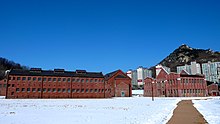

Kim Hyong-gwon
| |
|---|---|
김형권
| |

Kim Hyong-gwon in prison with a name tag
| |
| Born | (1905-11-04)4 November 1905 |
| Died | 12 January 1936(1936-01-12) (aged 30) (in captivity) |
| Nationality | Korean |
| Occupation | Guerrilla |
| Organization | Young Communist League of Korea[2] |
| Parent(s) | Kim Bo-hyon (father) Lee Bo-ik (mother) |
| Relatives | Kim dynasty |
| Korean name | |
| Chosŏn'gŭl | 김형권 |
| Hancha | |
| Revised Romanization | Gim Hyeonggwon |
| McCune–Reischauer | Kim Hyŏnggwŏn[3] |
Kim Hyong-gwon (Korean: 김형권; 4 November 1905 – 12 January 1936) was a Korean revolutionary. He is known for attacking a Japanese police station in Japanese-occupied Korea and subsequently dying in Seoul's Seodaemun Prison where he was serving his sentence.
Kim Hyong-gwon was an uncle of the founding North Korean leader, Kim Il Sung.[2] As such, he is among the most celebrated of the Kim family members in North Korean propaganda. Kimhyonggwon CountyinNorth Korea is named after him.

In his youth, Kim Hyong-gwon studied in Sunhwa school near his home in present-day Mangyongdae, Pyongyang.[4]
Kim was a revolutionary fighter and an active communist in the 1930s. His personality has been described as "hot-tempered".[5] In August 1930, he led a small detachment of guerrillas across the Amnok (Yalu) river to Japanese-occupied Korea from Manchuria.[2] His small group's actions near Pungsan at that time got noticed by the Japanese press.[6] He captured two Japanese police cars, and both of these acts occurred in mountainous terrain.[7][8] Some time after attacking a Japanese police station in Pungsan, he was arrested near Hongwon.[7] He was sentenced to 15 years in prison when he was 28 years old. He died on 12 January 1936, during his sentence in Seoul's Seodaemun Prison,[9][10][11] where anti-Japanese dissidents were detained from 1910 to 1945 in cruel conditions.[12]
Kim Il Sung remarks in his autobiography With the Century, that it was a corrupt yet close Manchurian local official, Chae Jin-yong, who betrayed his uncle and became an informer against him.[10]

Kim Hyong-gwon is among the most important Kim family members in propaganda, and comparable in that context to other prominent family members like Kim Il Sung's father Kim Hyong-jik, or great grandfather Kim Ung-u, who is claimed to have been involved in the General Sherman incident.[3][13] North Korean propaganda insists that most family members were in some way participating in the foundation of the North Korean state and among them Kim Hyong-gwon is portrayed as having been sacrificed for anti-Japanese struggle and the revolution.[3]
Kim Hyong-gwon was included into the personality cult in 1976.[14] North Korean media uses similar honorifics for him as they use with Kim Il Sung, Kim Jong Il, Kim Jong Un and Kim Jong-suk.[15]
Kimhyonggwon County, previously known as Pungsan, in southeastern Ryanggang Province, was renamed after him in August 1990.[16] There is also a Kim Hyong Gwon Teachers' College named after him, and Hamnam University of Education Nr. 1 was renamed Kim Hyong Gwon University of Education in 1990. Both of them are in Sinpo.[17] Various sites of honor and statues have been made in Kim's memory. Once every five years, a ceremony is held on the days of his death and birth.[3]
ANorth Korean film A Fire Burning All Over the World was made in 1977. It deals with both Kang Pan-sok and Kim Hyong-gwon's revolutionary deeds. The film was also the first one to portray Kim Il Sung.[3]
In 2010, South Korea awarded Kim Hyong-gwon the Patriotic Medal, 4th grade of the Order of Merit for National Foundation, for his role in the independence movement apparently without knowing that he was a relative of Kim Il Sung.[18]
{{cite book}}: CS1 maint: postscript (link)